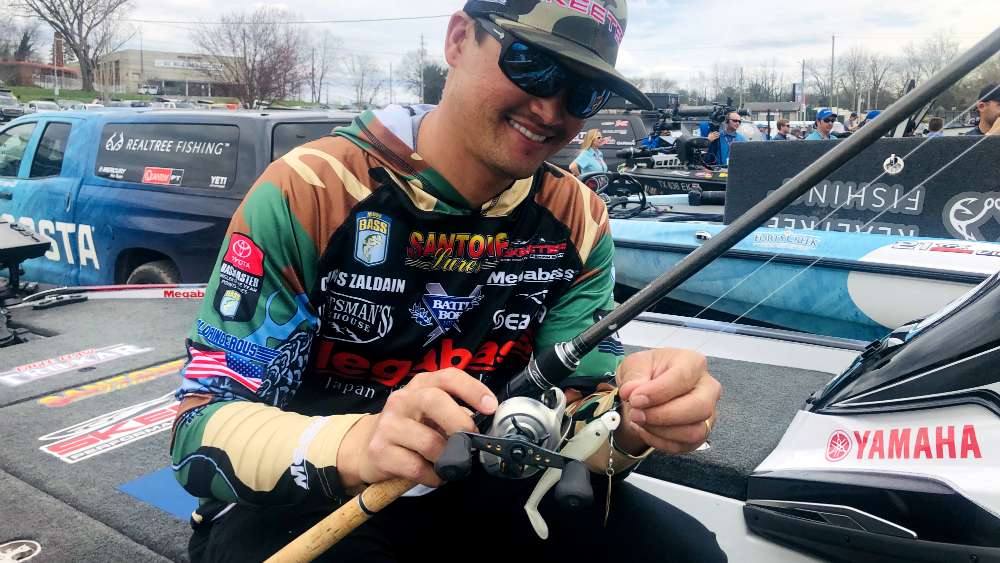
Rising and falling water. Warming water that goes from dingy to clear and back to muddy. A cold front and lots of rain. Prespawn bass constantly on the move. Here today gone someplace else the next day. Believe it or not, all are in play this week at the GEICO Bassmaster Classic presented by DICK’S Sporting Goods.
This 49th Classic is shaping up to be one of the most challenging of them all. The angler that hoists the world championship trophy on Sunday will have indeed earned his keep. Faced with a trifecta of uncontrollable variables, from weather to water of every kind, the 52 pros will be faced with constantly changing conditions.
“It’s going to be a wide-open, fly by the seat of your pants week,” observed Casey Ashley, the 2015 Classic winner. “Whoever takes that trophy will have adapted to all of the changes and dialed into a winning pattern.”
Ashley added the winner might not even figure out the pattern until the final day or even hours. Hang on. This one is going to be fun to watch.
What that all means for you is good news. The average angler stands to learn much and the timing couldn’t be better as spring fishing seasons approach. The Classic competition begins on Friday, but in the meantime pick up a few pointers on what the pros learned during practice.
Chris Zaldain: Be versatile
Chris Zaldain was fortunate to learn early on how versatility pays off in early spring. Growing up in California the conditions would call for fishing deep with a spinning rod or flipping shoreline cover, all in the same day.
“Especially this week at the Classic it will be important to be versatile,” he said. “We are facing so many unknowns and the best made plans can be eliminated without fail.”
Zaldain admitted it’s a crazy time of year to dial into a specific pattern, and that calls for some trial and error.
“I will always have a good, wide array of tackle to help me dial into the bite, knowing that it will eventually pan out in shallow water,” he continued. “But by all means fish with an open mind and avoid getting locked in to a specific tactic.”
A big part of that mindset is fishing patterns, not spots, until the fish settle in to their summer areas.
“Migrating bass are more reliable when you fish a textbook springtime pattern,” he said. “Just relying on spots will get you nowhere, because the fish will always be on the move.”
Brandon Palaniuk: Don’t spin out
The best advice from the 2017 Toyota Bassmaster Angler of the Year is to avoid spinning out when a preconceived game plan doesn’t fall into place.
“There is one word that sums up spring bass fishing and that word is change,” he said. “The temptation is when a preconceived game plan doesn’t work out to start running around, looking for new water or by fishing history.”
There is a better option and especially during prespawn when migrating bass are moving in the same direction, which is shallow and towards the bank.
“Get in an area where the fish can come to you, instead of wasting too much time running and gunning around.”
Palaniuk suggested setting up on known prespawn migration routes and especially transition areas. Creek channel swings with isolated cover on a shallow flat is an example. A steep bank bordered by a shallow point with rock or wood is another example.
In other words, a combination of deep and shallow water with structure that offers a retreat during a frontal passage or an ambush point for feeding. And if the fish aren’t at first there, come back later, and especially on sunny afternoons, when they are more prone to moving inshore.
Jacob Wheeler: Timing is everything
If sitting still and betting on the come isn’t your style then here’s a tip from Jacob Wheeler. A prerequisite is already having a confirmed pattern in place.
“You’ve got to be smart about timing your rotation of areas,” he said. “On pressured lakes, and especially this Classic, you want to hit fresh water first, before it gets fished by other anglers.”
The no-brainer is head first to your best water, with a twist.
“Water temperature is critical and on sunny days the backs of creeks and shallow spawning areas take time to get right,” he explained.
As the prespawn transitions into the spawn that is good advice. Prioritizing the rotation is a must by then.
“How you set that rotation comes during practice,” added Wheeler. “You just set the timing based on the odds of when it will likely turn on, or when is best to avoid showing up and someone else being on the spot.”
Bobby Lane: Fish with an open mind
Bobby Lane, a skilled shallow water angler, smiled as he admitted to having found evidence of some of the Classic bass population on the verge of spawning. Even so he recognized that change is ahead during the competition, with heavy rain and post-frontal conditions on the way.
“Fishing with an open mind is a must during spring, and you cannot get locked in to a pattern because it will be subject to change without notice,” cautioned the 12-time Classic qualifier. “Even if the pattern is reliable it might require fine tuning based on the changes in the water and weather.”
Lane’s wisdom is more mental than mechanical. That is good advice, considering the pent-up excitement of getting back into the game come springtime sometimes overshadows the mental side of forward, unhindered thinking.
Clifford Pirch: Think cold
Prespawn is the progressive migration of bass from deep water to the shallows. Much of that inshore movement is influenced by water temperature. Clifford Pirch advises lure selection should be taken into consideration as the strike zone expands from wide to narrow.
“A crankbait or a hard bait is ideal because of its versatility,” he explained. “You can fish it any number of ways, and that is important in cold water as it warms up and the fish stay on the move.”
To his point, the crankbait can be slow rolled in shallow water, burned down a riprap shoreline or retrieved to contact bottom structure at most any depth.
“The main thing is to keep up with the prevailing conditions and adjust presentations to match what the fish are doing.”

